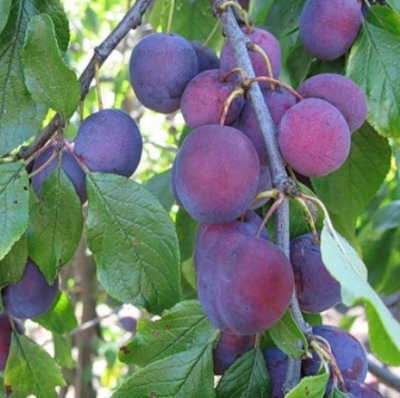
- Authors: E.P. Finaev (Kuibyshev experimental gardening station)
- Appeared when crossing: Early Ripening Red x Renclaude Bave
- Year of approval: 1971
- Growth type: vigorous
- Crown: oval-round, medium density
- Fruit size: large
- Fruit weight, g: 30,8
- Fruit shape: round, one-dimensional
- Fruit color: dark purple, solid
- Skin : medium, naked, with a strong waxy bloom, easily removable from the fetus
Mirnaya is a plum variety bred at the Kuibyshev gardening station and approved for use in 1971. During this time, the variety has proven itself well, it has been well studied and is loved by many Russian gardeners.
Description of the variety
It is a homemade plum with medium to above average vigor. The crown is oval-round in shape, not very dense; shoots are small, glabrous, with a small number of lentils; leaves are dark green, have a light fluff, slightly rough; during flowering, which occurs in the second decade of May, the tree is covered with beautiful medium-sized white flowers.
Fruit characteristics
Plums are large in size, the weight of each berry is about 30 g, round in shape. The peel is dark purple in color, with a strong waxy coating, and its main advantage is easy cleaning (for example, for a child), and although it is medium in density, it is still characterized by good keeping quality and transportability, the shelf life is 10-12 days.
Taste qualities
The fruit pulp is tender, juicy, the juice unobtrusively penetrates through the pores of the yellow-green pulp, so most consumers prefer to use the variety for fresh consumption. The berries are sweet and sour in taste, according to tasting they are rated at 4.8 points. The stone is well separated from the pulp, which allows this plum to be used for various types of processing.
Ripening and fruiting
The tree begins to bear fruit in 4-5 years after grafting when grown in a nursery, then the harvest will be every year. The variety belongs to the mid-early varieties, the first berries can be enjoyed in mid-late August.

Yield
Mirnaya belongs to varieties with a high yield. On average, a tree at the age of 6-8 years gives 8-12 kg of berries, a 9-12-year-old plant - 25-40 kg of yield.
Self-fertility and the need for pollinators
This is a self-fertile variety, however, in order to increase the yield, pollinating varieties can be planted next to the tree - plums with the same ripening period, for example, varieties Skorospelka red, Zhiguli, Kuibyshevskaya blue, Ternosliv Kuibyshevskaya.
Growing and care
A gardener who has chosen this variety for cultivation should know that this is a winter and heat-resistant variety, but it should be borne in mind that the berries can crumble when overripe, so harvest should be done on time.
Pay special attention to the tree even at the planting stage.
Choose a well-lit area for planting - this is important for a good volumetric crop.
Please note that groundwater does not flow closer than 1.5 meters from the surface.
Plum Mirnaya will feel uncomfortable in a soil with high acidity. To reduce acidity, add ash or dolomite flour while digging the ridge.
Soak the roots of the seedling in water with a diluted stimulant for 1-2 hours before planting.
The planting pit is dug to a depth of 50 cm, diameter - 70 cm. Drainage is laid at the bottom and a mixture of humus, ammonium nitrate, superphosphate is poured.
When planting, the root collar should be above ground level. After planting, the seedling is watered with water in the amount of 3-4 buckets, and the trunk circle is mulched with peat.
When caring for a tree, the following gardening tips will help.
Apply the first fertilizers only in the third year after planting. In the spring, use nitrogen compounds, in the fall, fertilizing with potassium and phosphorus will be appropriate.
If the season turned out to be dry, then Mirnaya plum should be watered 3-4 times for the entire time. If the plant is mature, use 4-5 buckets per square meter. m of the trunk circle.
To protect the crop from cracks in the trunk, which are formed when the branches are overloaded, they should be installed on supports.
When preparing Peaceful Plum for winter, dig up the tree trunk circle, add a layer of mulch, and treat the tree from rodents. To prevent freezing of the roots in winter, compact the snow in the trunk circle.




Disease and pest resistance
The plum variety Mirnaya has a low resistance to such pests as the plum moth. The preparations "Iskra Bio" or "Fitoverm" will help to get rid of this insect. In advanced cases, the chemical agents "Karbofos", "Inta-vir", "Lepidotsid" will be relevant.
Folk remedies, for example, infusions of garlic, hot pepper and onion husks, have also proven their effectiveness. As a preventive measure, collect the carrion on time, install trapping belts, dig up the soil in the fall, and treat all lesions on the trunk with garden varnish.

Despite the fact that plum is considered more hardy than many fruit trees, it is not immune from diseases. It is attacked by viral, fungal and bacterial infections, and parasitic insects harm it. It is necessary to notice and recognize the signs of plum disease in time. They are easier to deal with and defeat early on. Well, in order to protect the garden tree from such a misfortune in the future, preventive procedures can be carried out.



































































